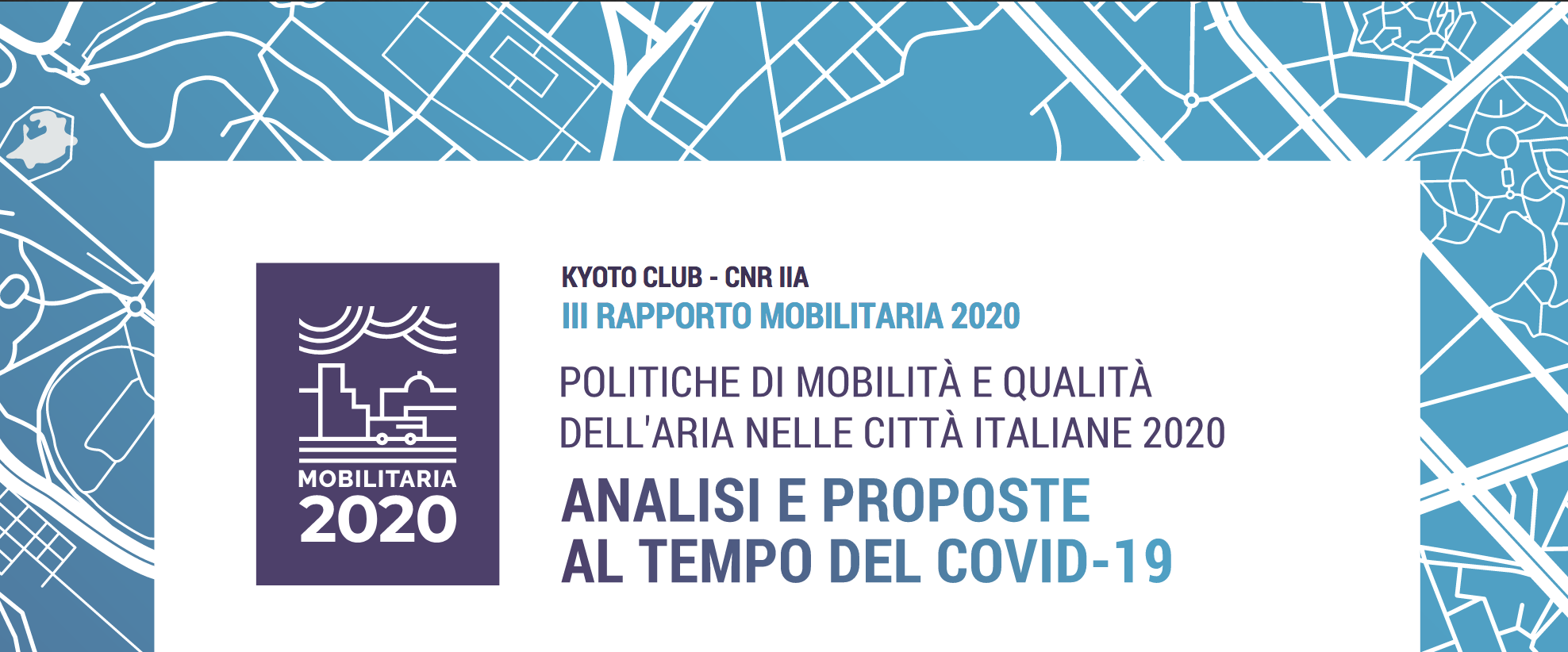
In 2019 the air quality in cities slightly improves compared to the previous year, however critical values remain that are not sufficient to guarantee compliance with the regulatory limits in force. During the lockdown period, on the other hand, thanks to the blocking of traffic, there is a sharp decrease in pollution, especially due to the collapse of nitrogen dioxide (NO2). In the meantime, the cities are trying to gear up to be more and more sustainable, while the Relaunch Decree just fired by the Government proves to be shy and insufficient to counter the growth of congestion and traffic that will gradually return to invade our cities after the restart: now more than ever, the just transition to sustainable mobility needs to be accelerated.
To this end, Kyoto Club and CNR-IIA put forward concrete proposals for phase 2 in the III Report, to counter the growth of vehicular traffic: smart working, traffic saving, city timetable plan, support for alternatives by bicycle, on foot, sharing mobility, micro-mobility, electric vehicles and collective transport.
These are the main themes of the third “MobilitAria 2020” Report which analyzes i mobility and air quality data in the 14 metropolitan cities in 2019 and in the first 4 months of 2020, in full Covid-19 emergency.
The lockdown period had considerable effects on the movements of citizens: consequently the level of emissions and pollution due to the transport sector marked a setback in Rome, Milan, Turin and Naples in the months of March and April 2020. , the four cities analyzed in this part of the study. Nitrogen dioxide (NO2) recorded a sharp decline.
The major collapse of NO2 occurred at Roma, where the average concentrations are lower than the previous years (2016-2019) respectively by -59% for the month of March and -71% for the month of April.
A Torino instead the decrease is of - 43% for the month of March and -51% for the month of April, Milano there was one reduction of -29% and -43% compared to the average of the same period 2016-2019, while Napoli record one respectively reduction of -33% and -57%.
"The analysis conducted on air quality for the year 2019 has shown the persistence for some Italian cities of high concentration values that are not sufficient to guarantee compliance with the regulatory limits in force" states the Director of the CNR-IIA, Francesco Petracchini, which specifies, “therefore greater efforts are needed on the part of local administrations to reduce concentrations and exceedances to the limit value. The effect on air quality was also analyzed in the period of the national lockdown following the epidemiological emergency from COVID-19. The two-month blockade made it possible to understand the important impact of vehicular traffic, in particular private traffic, as well as on the emissions of some pollutants also on the concentrations detected by the control units; this evidence is very marked, in accordance with what emerged from the analyzes of the same Agencies for pollutants linked directly to traffic, such as nitrogen dioxide and to a lesser extent but in the same way evident also for atmospheric particulate ".
From the point of view of urban mobility, the report analyzes what has happened in this year and a half at an urban, regional and national level, with the various measures and investments.
The SUMP, Urban Sustainable Mobility Plan, of the 14 municipal or metropolitan cities, with the current status and main contents. PUMS which by October 2020, all metropolitan cities will have to approve.
In 2020 with the coronavirus emergency many municipal administrations have prepared, and are now starting to implement, Mobility Plans for Phase 2 restart, to encourage the growth of cycle and pedestrian movements in safety, to reorganize LPT services, enhance sharing mobility, stagger schedules, encourage smart working and online services.
"The lockdown has reduced traffic, pollution and CO2 emissions, but we want to get back to moving without polluting and congesting the cities" says the coordinator of the Kyoto Club “Sustainable Mobility” working group, Anna Donati. “This is possible if we accelerate investments and measures to travel by bicycle, on foot, with sharing mobility and micro-mobility, if we innovate public transport services and focus on the electrification of vehicles. The DL Relaunch is just a timid attempt to go in this direction, much more is needed and we ask that the DL be improved and the next measures are more effective ".
Even in times of Covid-19, structural changes and strong innovations are needed that accelerate decarbonization with an intelligent mobility offer - according to the Avoid, Shift, Improve principles. For Kyoto Club and CNR-IIA to achieve these objectives it is necessary to implement various measures. Between these: enhance smart working and proximity services to decongest cities; plan entrance times at work, in schools, in public and private services, in commercial services to reduce peak hours and make the best use of the spaces and services available; expand sharing mobility services, promote cycling through the expansion of cycle paths and services for cyclists; support public transport; strengthen the figure of the mobility manager; reorganize logistics in a sustainable way; focus on the electrification of vehicles and maintain ztl and low emission zones.
"It seems clear that the exit from the pandemic crisis puts us at a crossroads" - commented the Vice President of Kyoto Club, Francesco Ferrante. "The 'conservative' thrust of those who think that the best response to the needs of social distancing will prevail is to shut themselves up in their own private car, perhaps by encouraging the purchase of models that have remained unsold in recent months, or rather a more modern model based on on the strong strengthening of local public transport, sharing, forms of soft and sustainable mobility and which incentives technological innovation by accelerating the exit from the "fossil era" also in transport? Only if he knowsremo able to win the second option potremo go back to living in beautiful, welcoming cities, full of life and clean air ”.
